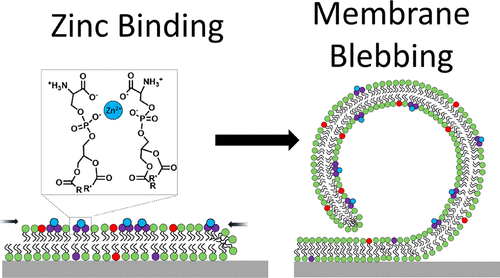当前位置:
X-MOL 学术
›
J. Am. Chem. Soc.
›
论文详情
Our official English website, www.x-mol.net, welcomes your
feedback! (Note: you will need to create a separate account there.)
Zn2+ Binds to Phosphatidylserine and Induces Membrane Blebbing
Journal of the American Chemical Society ( IF 14.4 ) Pub Date : 2020-10-20 , DOI: 10.1021/jacs.0c09103 Matthew F. Poyton , Saranya Pullanchery , Simou Sun , Tinglu Yang , Paul S. Cremer
Journal of the American Chemical Society ( IF 14.4 ) Pub Date : 2020-10-20 , DOI: 10.1021/jacs.0c09103 Matthew F. Poyton , Saranya Pullanchery , Simou Sun , Tinglu Yang , Paul S. Cremer

|
Herein, we show that Zn2+ binds to phosphatidylserine (PS) lipids in supported lipid bilayers (SLBs), forming a PS-Zn2+ complex with an equilibrium dissociation constant of ∼100 μM. Significantly, Zn2+ binding to SLBs containing more than 10 mol % PS induces extensive reordering of the bilayer. This reordering is manifest through bright spots of high fluorescence intensity that can be observed when the bilayer contains a dye-labeled lipid. Measurements using atomic force microscopy (AFM) reveal that these spots represent three-dimensional unilamellar blebs. Bleb formation is ion specific, inducible by exposing the bilayer to μM concentrations of Zn2+ but not Mg2+, Cu2+, Co2+, or Mn2+. Moreover, Ca2+ can induce some blebbing at mM concentrations but not nearly as effectively as Zn2+. The interactions of divalent metal cations with PS lipids were further investigated by a combination of vibrational sum frequency spectroscopy (VSFS) and surface pressure-area isotherm measurements. VSFS revealed that Zn2+ and Ca2+ were bound to the phosphate and carboxylate moieties on PS via contact ion pairing, dehydrating the lipid headgroup, whereas Mg2+ and Cu2+ were bound without perturbing the hydration of these functional groups. Additionally, Zn2+ was found to dramatically reduce the area per lipid in lipid monolayers, while Mg2+ and Cu2+ did not. Ca2+ could also reduce the area per lipid but only when significantly higher surface pressures were applied. These measurements suggest that Zn2+ caused lipid blebbing by decreasing the area per lipid on the side of the bilayer to which the salt was exposed. Such findings have implications for blebbing, fusion, oxidation, and related properties of PS-rich membranes in biological systems where Zn2+ concentrations are asymmetrically distributed.
中文翻译:

Zn2+ 与磷脂酰丝氨酸结合并诱导膜起泡
在此,我们表明 Zn2+ 与支持的脂质双层 (SLB) 中的磷脂酰丝氨酸 (PS) 脂质结合,形成 PS-Zn2+ 复合物,其平衡解离常数约为 100 μM。值得注意的是,Zn2+ 与含有超过 10 mol% PS 的 SLB 结合会引起双层的广泛重新排序。这种重新排序通过高荧光强度的亮点表现出来,当双层含有染料标记的脂质时,可以观察到这种亮点。使用原子力显微镜 (AFM) 进行的测量表明,这些斑点代表三维单层气泡。气泡形成是离子特异性的,可通过将双层暴露于 μM 浓度的 Zn2+ 而不是 Mg2+、Cu2+、Co2+ 或 Mn2+ 来诱导。此外,Ca2+ 可以在 mM 浓度下引起一些起泡,但不如 Zn2+ 有效。二价金属阳离子与 PS 脂质的相互作用通过振动和频光谱 (VSFS) 和表面压力-面积等温线测量的组合进一步研究。VSFS 显示 Zn2+ 和 Ca2+ 通过接触离子配对与 PS 上的磷酸根和羧酸根部分结合,使脂质头基脱水,而 Mg2+ 和 Cu2+ 在不干扰这些官能团的水合作用的情况下结合。此外,发现 Zn2+ 显着减少脂质单层中每个脂质的面积,而 Mg2+ 和 Cu2+ 则没有。Ca2+ 也可以减少每个脂质的面积,但仅当施加显着更高的表面压力时。这些测量结果表明,Zn2+ 通过减少盐所暴露的双层一侧的每个脂质的面积而引起脂质起泡。
更新日期:2020-10-20
中文翻译:

Zn2+ 与磷脂酰丝氨酸结合并诱导膜起泡
在此,我们表明 Zn2+ 与支持的脂质双层 (SLB) 中的磷脂酰丝氨酸 (PS) 脂质结合,形成 PS-Zn2+ 复合物,其平衡解离常数约为 100 μM。值得注意的是,Zn2+ 与含有超过 10 mol% PS 的 SLB 结合会引起双层的广泛重新排序。这种重新排序通过高荧光强度的亮点表现出来,当双层含有染料标记的脂质时,可以观察到这种亮点。使用原子力显微镜 (AFM) 进行的测量表明,这些斑点代表三维单层气泡。气泡形成是离子特异性的,可通过将双层暴露于 μM 浓度的 Zn2+ 而不是 Mg2+、Cu2+、Co2+ 或 Mn2+ 来诱导。此外,Ca2+ 可以在 mM 浓度下引起一些起泡,但不如 Zn2+ 有效。二价金属阳离子与 PS 脂质的相互作用通过振动和频光谱 (VSFS) 和表面压力-面积等温线测量的组合进一步研究。VSFS 显示 Zn2+ 和 Ca2+ 通过接触离子配对与 PS 上的磷酸根和羧酸根部分结合,使脂质头基脱水,而 Mg2+ 和 Cu2+ 在不干扰这些官能团的水合作用的情况下结合。此外,发现 Zn2+ 显着减少脂质单层中每个脂质的面积,而 Mg2+ 和 Cu2+ 则没有。Ca2+ 也可以减少每个脂质的面积,但仅当施加显着更高的表面压力时。这些测量结果表明,Zn2+ 通过减少盐所暴露的双层一侧的每个脂质的面积而引起脂质起泡。











































 京公网安备 11010802027423号
京公网安备 11010802027423号